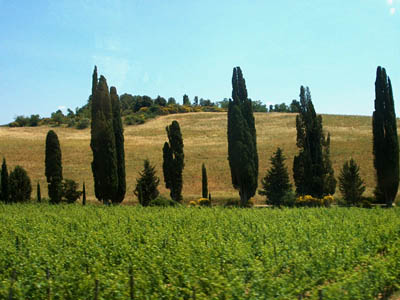
The hills of Tuscany
On the first day of the conference, there was a bus from Florence to the conference site, about an hour away. All we had to do was turn up at the bus station by 11, which sounded much easier than it was. Leaving our vaulted brick den a bit late, we called a taxi and explained where we wanted to go. The driver drove us (I would say directly, but in fact, given the one-way streets, pedestrian zones, and perpetual student demonstrations that occupy most of central Florence, it was more like driving our Fiat Theseus through a maze) to the train station, not the bus station. We figured the bus station must be nearby, and, wandering around in classic lost-American style, we were assured by various people that in fact, there were several bus stations nearby. "Which one do you want?" "The one with my bus in it." We couldn't find the right one. After several encounters with fast-talking, hand-waving locals, we finally figured out that the station we needed was tucked inside a building around a corner, with no obvious marking in front. So we wheeled our way through the heat and into the station, with just enough time for one last espresso before the bus left for Siena.

The hills of Tuscany
The conference we were in Italy to attend was held in a monastery tucked in the hills of Tuscany outside of Siena, about an hour south of Firenze. The monastery, originally a charterhouse, is called the Certosa di Pontignano, which means "freakin' cool place to have a conference", and now belongs to the University of Siena. The University, in a display of enormous taste, flair, and generosity, uses it as a conference center and hotel for academics. We were one of two or three groups treated that week to a few days in the monastery, complete with all meals served in the air-conditioned dining hall during the day, and outside in the cloister in the cool evening.
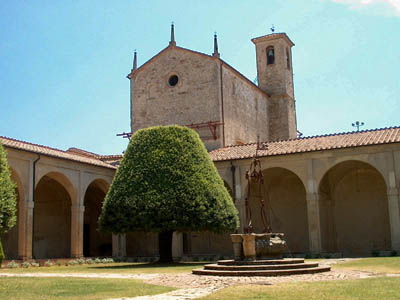
La Certosa di Pontignano
There was one big surprise at the Certosa: When we walked down the echoing stone corridor to our room and turned the heavy key in the lock, the door swung open to reveal a room done up in shocking yellow and blue, full of plastic furniture and decorated like a German dorm room from the mid-Eighties. The contrast knocked us flat on the cold marble floor. The bathroom was oddly equipped with fixtures that were somewhere between modern Germany and medieval Italy. Suffice it to say that the rooms were not the best part of the monastery. Especially since every time someone coughed in the next room, it set up a reverberating echo up and down the stone corridors that lasted about seventeen minutes. A weird sort of hotel.
But we were very impressed by the wine. At every meal (except breakfast), we were served University of Siena wine, made right there from grapes grown in the University vineyards. It may have been made by agriculture students, but let me tell you, the experience was far superior to getting a haircut from a hairdressing student, or--god forbid--dental work from a dental student, which a friend of mine has described to me in too much detail. The wine, both red and white, was quite good and apparently in limitless supply, so I'm afraid I don't actually remember the conference.
Well, there is one thing I remember: Although this place was extremely high-tech compared to most monasteries (they had a computer lab, for example), the air-conditioning was confined to the dining hall. The hall in which we held all of our meetings had frescoes and tapestries, as well as an LCD projector and a ceiling-hung screen, but it had nothing in the way of ventilation. Given that we were in the middle of a heat wave, I was surprised that they had not even put any fans in the room. After about the twelfth person had passed out from the heat, they managed to scrounge up a couple of fans, of the oscillating desk-top variety--not really enough to give relief to a hundred sweating linguists.
In this atmosphere, we sat through some presentations by well-intentioned young students whose work was fair but whose English was awful, and others by better-known academics whose English was much better than their work. So imagine the relief when Annelie took the lectern, and in her gorgeous, lilting, British English, gave a crystal-clear PowerPoint presentation (with terrific animations, if I do say so myself), outlining with limpid and disciplined prose her revolutionary ideas on the subject of metadiscourse. The crowd went wild; they cried and fainted; they spontaneously cheered; champagne was fetched and toasts were made as Annelie was raised on shoulders and paraded into the cool of the dining hall to be garlanded with lilies and roses.
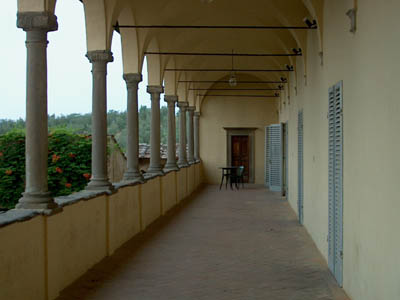
Arcades at the Certosa
All right, it wasn't exactly like that, but her presentation was extremely well received. I was very proud of her, and relieved that from now on all we had to do was listen. The conference was good, but I'm sure you don't want to hear any of the details. As with most conferences, it was an exhausting regimen of paper sessions, invited talks, round tables, and rectangular tables with lots of wine on top.
The weirdest part of the whole experience was the fact that for three days, we actually did not leave the monastery. With a shock, I realized that I now knew literally what it felt like to be cloistered! Having just spent a week in Palo Alto at the Hotel California, I was a bit nervous that we might never leave. (An aside about the Hotel California: One of the things that I found creepy about that place, which wasn't really creepy at all otherwise, was the total lack of references to the famous Eagles song. No mention on the website, no picture of Don Henley, nothing. This made me suspicious. So, on my last morning there, I had to tempt fate by asking the clerk, "Hey, can I check out any time I like?" I breathlessly awaited his reply. He let me hang for a moment, and then said "Sure." I didn't know whether to be disappointed or relieved.)
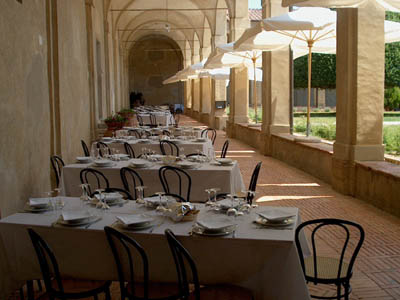
Not such a bad place to be cloistered
When the conference ended, Annelie and I had an inspiration: We would stay on for another night after everyone else had left and explore the hills around the monastery, which we had had no time to do so far. The staff seemed to think this was great, provided that we paid for the room, so we waved goodbye to the busload of linguists and returned to our "mod" little room, just as the storm began.
After several days of insufferable heat, suddenly a thunderstorm had materialized out of nowhere. The sky turned black, there were loud crashes, the computers went down, and the heavens dumped water on us by the gallon--uh, liter. I mean, litre. This made hiking seem like less of a good idea. We pushed the bed up to the window and watched the swallows freaking out in the courtyard.
We went to Siena for the evening, which involved a brisk bus ride through lumpy, vineyard-covered hills. The approach to the city involved corkscrewing up, and up, and up, and up: Siena is an old, walled city on top of a high hill. More medieval and less Renaissance in feel than Firenze, its dark, cobbled streets are a lovely maze full of incredibly "authentic"-seeming buildings.
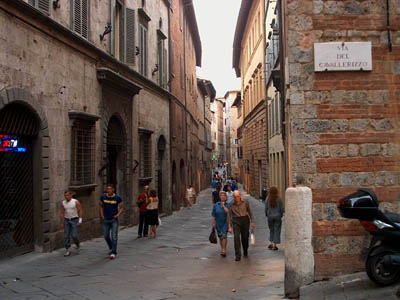
Out for a walk in Siena

In the main piazza

Morning at the Certosa di Pontignano
Then we had to pack up our things, say arrivederci to the Certosa, and take a taxi back to Siena. But this time we went only as far as the train station, because we were now done with Italy. It was time to move on to Spain.